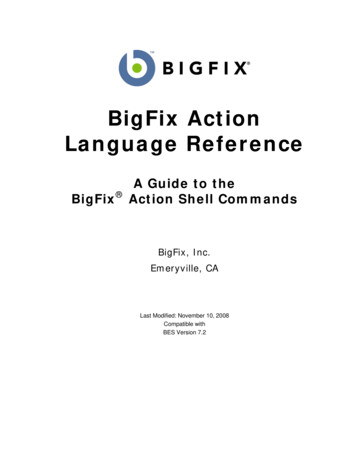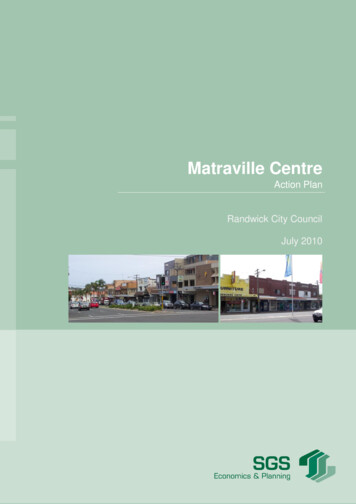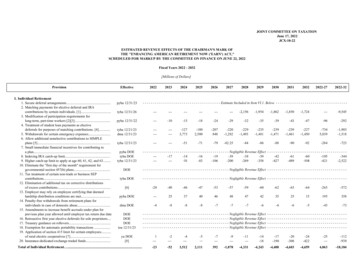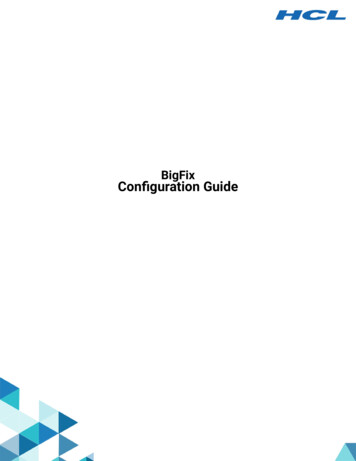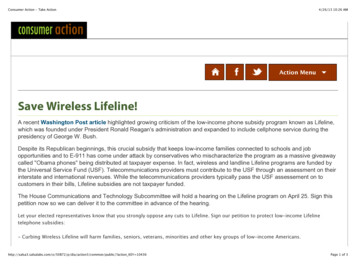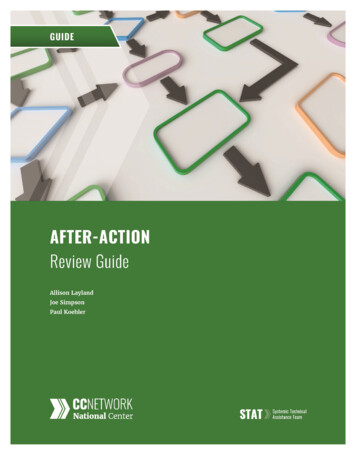
Transcription
After Action Review GuideThe National Comprehensive CenterThe National Comprehensive Center (NCC) is one of 20 technical assistance centers supported under theU.S. Department of Education’s Comprehensive Centers program from 2019 to 2024. The NCC focuses onhelping the 19 Regional Comprehensive Centers and state, regional, and local education agencies throughoutthe country to meet the daunting challenge of improving student performance with equitable resources.This publication is in the public domain. While permission to reprint is not necessary, reproductions should be cited as:Layland, A., Koehler, P., Simpson, J. (2020). After Action Review Guide. Rockville, MD: National ComprehensiveCenter at Westat.The contents of this publication were developed under a grant from the Department of Education. However, the contentsdo not necessarily represent the policy of the Department of Education, and you should not assume endorsement by theFederal government.A copy of this publication can be downloaded from etwork.org1
ContentsIntroduction3Background3Common AAR Questions and Answers5Overview of the AAR4Who should use an AAR?5How much time is needed to complete an AAR?5Who should participate in an AAR?5When should an AAR be used?5What resources are needed for an AAR?5Where should an AAR take place?5Types of AARs6Reasons to Conduct AARs6Conducting an AAR8Planning an AAR7Using the Results of the AAR10Appendix A: AAR Planning Checklist12Appendix C: AAR Key Questions14Appendix E: 5 Whys Template18References11Appendix B: AAR Ground Rules13Appendix D: AAR Templatewww.compcenternetwork.org182
After Action Review GuideIntroductionResponding to complex problems and emergencies such as COVID-19 requires both rapid responseand long-term planning. Part of the response and planning needs to be based on lessons learnedfrom previous crisis experiences. Organizations should be routinely conducting strategic reviews ofprevious responses, projects, or events to analyze the implementation and effect of actions,document lessons learned, and apply those lessons in new conditions. Regional ComprehensiveCenters can assist state education agencies (SEAs) or local education agencies (LEAs) in reviewingactions, identifying the lessons learned, and applying the lessons to continually improve studentoutcomes. An After-Action Review is a method for conducting such reviews.BackgroundAn After-Action Review (AAR) is a method for extracting lessons from one action, event, or project,and applying the lessons learned to others. It enables a team to analyze for themselves whathappened, why it happened, and how to use learnings to sustain strengths and improveweaknesses.AARs were originally developed by the U.S. Army’s National Training Center for use by theOpposing Force, a 2,500-person brigade charged with preparing soldiers for combat (TrainingCircular 25-20). AARs became well known when companies such as Shell Oil, Colgate-Palmolive,and Harley-Davidson used them to identify best practices and mistakes not to repeat.An AAR is “a living, pervasive process that explicitly connects past experience with future action”(Darling, et al., 2005, p. 3). It offers a structured process to gain candid insights into an individualsor team’s strengths and weaknesses from a variety of perspectives, feedback, and specific criticaldetails that may have been missed in a typical evaluation report. AARs are especially importantwhen a problem or situation lingers, and lessons learned can be incorporated into future planning.“By creating tight feedback cycles between thinking and action, AARsbuild an organization’s ability to succeed in a variety of conditions.Former [participants now in the field] take with them not just a set oflessons but also a refresher course on how to draw new lessons fromsituations for which they did not train—situations they may not evenhave imagined. In a fast-changing environment, the capacity to learnlessons is more valuable than any individual lesson learned.” (Darling,et al., 2005, p. 9)www.compcenternetwork.org3
After Action Review GuideAn AAR is a crucial but often neglected activity in organizations. Most organizations usepostmortems of past failures, or a debrief session, in order to be more successful in the future. Oftenthose efforts result in static reports that are all too often filed away and forgotten. Or, if an AAR isattempted, not enough time is given to the process, or the AAR is focused on critiquingperformance, which only provides one point of view, focuses on error and blame, and often lacksparticipant discussion of the actions. A high-quality AAR, however, is an in-depth process duringwhich the learnings are incorporated into the organization’s strategic direction, daily operations,and implementation process, leading to true improvement.Overview of the AARThe purpose of an AAR is to determine what worked and what didn’t to help refine anorganization’s ability to predict what will work and what won’t in the future. The AAR is part of abroader cycle of improvement during which explicit linking of lessons to future actions occurs. Thegoal is to improve performance at multiple levels of the organization, e.g., individual, team, division,so the organization is more cohesive and effective as a whole.Figure 1. AAR cycleAARs are conducted during or immediately after each event, such as a response to a crisis ordisruption or a project. An AAR focuses on the intended objectives of the event or project as well asindividual, team, and leader performance. It engages all participants in discussions using openended questions. The questions are related to specific standards established when the project orevent was planned. The discussions lead to identification of strengths and weaknesses that are thenlinked to performance. The knowledge gained is then applied to a future project or event to validatethe findings and improve performance.www.compcenternetwork.org4
After Action Review GuideCommon AAR Questions and AnswersWho should use an AAR?Any leader or team who wants to maximize learning from their actions and apply those learnings toimprove performance and results.When should an AAR be used?An AAR can be used immediately after an action, event, or at the end of a project. It is critical thatthe review occurs within 1 to 2 weeks of the event or project. It can also be used during key phasesof a longer project or informally during project implementation.How much time is needed to complete an AAR?Typically, a formal AAR at the organization or division level requires at least 4 hours, whereas anAAR for a team, office or unit would take about 2 hours. An informal review could be conducted inwhatever time a team can allot. “A conversation as short as 15 minutes might identify barriers toprogress and strategies to overcome them,” (Salem-Schatz, et al., n.d.). While an AAR can be quick,an AAR should never be rushed! In other words, enough time needs to be given to the AAR processregardless of whether it is formal or informal.What resources are needed for an AAR?Formal AARs call for a facilitator and possibly external observers, depending on the event orproject. Informal AARs can be led by the unit leader or a team member who has the full support ofthe unit leader to guide the process. The facilitator captures the discussions and key points. Inaddition, each participant should have notetaking tools so they can take notes during discussions.For example, the facilitator can repeat back a key discussion point and the participant canformulate a reflection to add to the discussion.Who should participate in an AAR?All leaders and team members who were responsible for and participated in the event or project,including consultants or contractors, should participate in the AAR. It is critical that they participateand take notes during the review. Ownership of the process by all is critical to its success.Where should an AAR take place?Informal AARs take place wherever they are needed during implementation, which is usually wherethe actions are taking place. For example, an AAR could be conducted at a school where anintervention is being implemented as part of and evidence-based intervention project. Formalreviews should take place where it is conducive and comfortable for all participants to attend andengage in the discussions. For example, a formal AAR could take place back at the project office in aconference room or through a virtual meeting.www.compcenternetwork.org5
After Action Review GuideTypes of AARsAARs can be formal or informal. Formal AARs usually help at the organization or division levels.During a formal AAR, an external facilitator or leader facilitates the review and focuses on adiscussion of the event objectives. At the end, the leader reviews key points and issues identified asthey relate to the key objectives.Informal AARs mostly occur at the unit level and can be used when coaching an individual or teamduring project or event implementation. Feedback on individual or team roles related to the projectobjectives as well as individual or team performance related to overall project results is providedimmediately.The main difference between the formal and informal AARs is the amount of time, and resourcesneeded, and when the AAR takes place Table 1 provides more detail on the differences.Table 1. Formal and Informal After-Action ReviewsFormal After-Action ReviewsInformal After-Action Reviews» Are conducted by a leader or facilitator andcan include external observers» Take less time» Take more time» Are scheduled when needed» Are scheduled beforehand» Are conducted at the event or project site orback at the base of operations» Are conducted where best supported» Are conducted by internal staffSource: Adapted from U.S. Department of Army (1993). A Leader’s Guide to After-Action /Files/Topical/After Action Report/resources/tc25-20.pdfReasons to Conduct AARsBoss (2016) notes 6 key reasons to conduct an AAR.» An AAR allows leaders and team members to think strategically because their purpose is toquestion all previously held assumptions and beliefs that spark curiosity.» AARs build shared contextual awareness, breaking down long-standing silos by increasing clearcommunication within and across silos.» AARs help sustain competitive advantage and save time and costs related to ramping up newstaff by providing a “go-to knowledge bank with inferred knowledge” that cannot be gleanedfrom an organizational chart.» AARs create conditions for innovation by providing employees with a collective source ofinformation that allows a fresh look at old problems.» AARs enable strategic decision-making by helping build pattern recognition that heightens riskperception.www.compcenternetwork.org6
After Action Review Guide» AARs minimize interpretations by providing clarity in learning, which leads to a focus on workproductivity rather than how to carry out the work.For Regional Centers, SEAs, or LEAs, AARs can be used to reflect on actions taken to address crises,such as a pandemic, or longer term projects, such as a series of professional development sessionson evidence-based practices or a pilot of a new program. An AAR can be part of a cycle ofimprovement whereby an AAR is routinely used to reflect on actions taken and how to use thelearning to improve processes and procedures.Planning an AARPlanning is critical to the success of an AAR (see the planning checklist in Appendix A). Thefacilitator meets with the organization, division, or unit leader (depending on the level of the AAR)before the AAR to determine the logistics of conducting the AAR including:The date, time, and location for the AAR. The review should be conducted in person wheneverpossible, however, it could be accomplished through a virtual meeting.» The participants and how to ensure all team members are included and can be present. If a teammember cannot be present, gather input through an interview, conference call, or videoconference.» The meeting roles:› Notetaker: A notetaker is designated to chart discussions and decisions. If the meeting ismore than 1 hour it would be prudent to have more than one notetaker to rotate.› Timekeeper: A timekeeper is assigned to keep the process flowing based on approximatetime allotted for each question, however flexibility is needed based on the discussions. Stricttimekeeping could limit important contributions. The AAR should determine the amount oftime needed as opposed to the time allotted for the AAR. The facilitator or leader keeps thingsflowing and does not allow distracting digressions. Focus on the AAR is critical. The AAR isthe objective, not an arbitrary schedule.» Confirmation of the event or project mission, purpose, and intended results (including outputsand outcomes). If a project plan was created, review the plan to gain a sense of the order ofactions and expected outputs.» The ground rules for the review. These could be the established norms of the organization orones the team agrees upon at the beginning of the review. Here is an example of possible groundrules:› Actively participate› Value all points of view› Be open to new ideas› Use “Yes and,” rather than either/or thinking› Build consensuswww.compcenternetwork.org7
After Action Review Guide› Take notes› Focus on issues that can beaddressed, not on issues outside theorganization’s sphere of influenceFACILITATOR TIPS» Give participants time to think about and writedown their recollections.› Be candid» It is important that participants focus on whattranspired without judging what was good orbad.› Acknowledge one’s own mistakes» Make sure each participant has a chance tospeak. Ask participants to be specific and avoidgeneralizations.› Focus on improving performance, notplacing blameConducting an AARAn AAR begins with restating the task,purpose, intent, and anticipated results orend state. These should be posted andclearly visible to all participants since theyare the key focus of the review—“Did wecarry out the work as intended for thepurpose and did we get the anticipatedresults?” This task is best accomplished bythe leader of the organization/unit as it setsthe tone and expectations of ownership andaccountability of the leader.Participants then discuss the followingquestions while the facilitator andnotetaker capture key points of thediscussions.1. What was expected to happen?› What was the purpose and what werethe objectives?› Who was the targeted audience?› What was the time frame?» Ask probing follow-up questions to assist aparticipant in getting to the specifics. Forexample, a follow-up question might be asked toencourage a participant to provide more specificdetails, e.g., Tell me what you mean?» Summarize and repeat back responses to verifywith the person who made the statement thatthe notes or summation accurately reflects theirintended response.» Periodically, summarize and repeat back the keydiscussion points to the entire group. This alsoassists the notetaking in recording responsesthat accurately reflect the person’s statementand the group’s discussion points.» Acknowledge feelings, but focus participants onsharing the facts. For example, e.g., It sounds likeyou felt frustrated, What specifically happenedthat led to the frustration?» Encourage each participant to share whathappened from their own point of view, e.g., owdid you perceive the interaction?» Relate actions to subsequent results, e.g., Whatwas the result of that action?› Who was involved?› What were the intended outputs and outcomes?› What were the anticipated barriers? How were those to be addressed?2. What actually happened?› When were actions initiated?› Why were certain actions taken?www.compcenternetwork.org8
After Action Review Guide› What intended actions were missed?Why?› How did each participate react tocertain situations?3. What went well and what didn’t work?(What caused our results?)› What were the successful steps takentoward achieving the objectives?› What went really well? Why?› What had the greatest effect on theteam’s success?› What missteps occurred? Why?4. What will we sustain or improve? Whatwill we do to adapt or refine ourexecutions for a better outcome?› Given the information and knowledgewe had at the time, what could havebeen done better?› Given the information we have now,what can we do differently?› What advice could be given to a teambased on the experiences anddiscussions we have had?FACILITATOR TIPS» Relate actions to subsequent results.» Recognize that most lessons that first surface areincomplete or wrong, representing what the unitthinks should work, not what really does work» Do not pass judgment. Let everyone be heard.Point out that during this section, positive andnegative points will be shared.» Ask probing questions and why multiple times toget to root causes (e.g., the 5 whys technique inAppendix E).» Emphasize the positive and point out thedifficulties in making really tough decisions in themoment, especially when the discussion starts tofocus on errors.» Summarize and identify emerging themes.FACILITATOR TIPS» Engage the team in exploring alternative coursesof action that might have been more effective,e.g., How might this have been handleddifferently?» Make sure discussions of errors do not becomeThe facilitator closes an AAR byblame focused, pointing fingers at others, e.g.,summarizing the key points that emergedWhat gap or barrier caused the error?from the discussion, and identifying» Compliment those who are acceptingrecommendations for future events orresponsibility for errors on being accountable,projects based on learnings. It is importante.g., We appreciate the ownership of the errorto link observations to recommendationsand let’s work together to learn from thefor future improvements. In addition, theexperience.facilitator engages participants in» Continually bring the focus back to the originalIdentifying concrete next steps for followintent, objectives, and results by asking howup and assigning persons responsible forthings could have been done differently toeach step along with a timeline. Finally, theachieve better results, e.g., How did this actionparticipants identify how AAR results willsupport the overall objectives?be shared with team members and othersoutside of the team (e.g., the lessons will beshared, but without individual comments/attacks/etc.).www.compcenternetwork.org9
After Action Review GuideUsing the Results of the AAR“At most civilian organizations we studied, teams view the AAR chiefly as a tool for capturinglessons and disseminating them to other teams. Companies that treat AARs this way sometimeseven translate the acronym as after-action report instead of after-action review, suggesting that theobjective is to create a document intended for other audiences” (Darling, et al., 2005). In contrast,the U.S. Army’s Operation Force believes a unit hasn’t learned the lesson until there is a change inbehavior.The above statements point out the importance of using the AAR results to improve performance.Not all AARs involve correcting what went wrong. Some involve applying what went right underdifferent conditions or circumstances. An AAR provides an opportunity to experiment andcontinually improve by sustaining those actions that work and applying variations to get evenbetter results. Evidence gathered through AARs can add to a body of evidence that builds bestpractices to continue or expand. The facilitator supports leadership in planning and implementingthe lessons learned and conducting AARs to determine if the variations work. The AARs thenbecome part of the overall continuous improvement process of the organization, its divisions andunits, and its people.The facilitator works with the leader or leadership team to create a report that provides a clearsummary of concrete and actionable recommendations for improvement and an action plan toapply lessons learned to an upcoming event or project. Lessons learned may indicate that executionfailed due to lack of communication, an overlooked barrier in the planning process, or poorperformance on the part of an individual or team. While it is desirable to keep things positive, thesefailures must be acknowledged, owned, and addressed by focusing on the role that the action(s)played in the failure of the mission and ways to prevent a repeat of the error.COVID-19 provides an opportunity to reflect on actions taken, the effectiveness of the actions, andlessons learned from the rapid responses in changing contexts. An AAR provides a method forreflection which can be used by state, district, and school leaders to improve education servicedelivery.www.compcenternetwork.org10
After Action Review GuideReferencesDarling, M., Parry, C., & Moore, J. (2005). Learning in the thick of it. Harvard Business Review, JulyAug 2005. Retrieved from tSalem-Schatz, S., Ordin, D., & Mittman, B. (n.d.). Guide to the after-action review. Center forImplementation Practice and Research Support. Retrieved on May 14, 2020 -to-the-after action review.pdfTraining Circular 25-20, A leader’s guide to after-action reviews, Headquarters, Department of theArmy, Washington, D.C., 30 September 1993. Retrieved es/Topical/After Action org11
After Action Review GuideAppendix A: AAR Planning ChecklistAfter-Action Planning Checklist1. Determine a date, time, and location for the AAR. The review should be conducted inperson whenever possible.2. Identify participants and ensure all team members are included and can be present.3. Determine meeting roles:› Notetaker to chart discussions and decisions. If the meeting is more than 1 hour itwould be prudent to have more than one notetaker to rotate.› Timekeeper: Time should be assigned to questions during the review to keep thereview flowing and allow time for wrap-up.4. Review the event or project mission, and the purpose and intended results. If a projectplan was created, review the plan to gain a sense of the order of actions and expectedoutputs.5. Establish ground rules for the review. These could be the established norms of theorganization if they are used.6. Determine required supplies and equipment whether the meeting is face-to-face orvirtual (e.g., Flip charts, markers, tape, recorder, computer, projector, virtual tools suchas Padlet)www.compcenternetwork.org12
After Action Review GuideAppendix B: AAR Ground RulesAfter-Action Review Ground Rules»»»»»»»»»»Actively participateValue all points of viewBe open to new ideasUse “Yes and,” rather than either/or thinkingBuild consensusTake notesFocus on issues that can be addressed, not on issues outside the organization’ssphere of influenceBe candidFocus on improving performance, not placing blameAcknowledge one’s own mistakeswww.compcenternetwork.org13
After Action Review GuideAppendix C: AAR Key QuestionsAfter-Action Review Key Questions1. What was expected to happen?a. What was the purpose and what were the objectives?b. Who was the targeted audience?c. What was the time frame?d. Who was involved?e. What were the intended outputs and outcomes?f. What were the anticipated barriers? How were those to be addressed?2. What actually happened?a. When were actions initiated?b. Why were certain actions taken?c. What intended actions were missed? Why?d. How did each participant react to certain situations?3. What went well and what didn’t work? (What caused our results?)a. What were the successful steps taken toward achieving the objectives?b. What went really well? Why?c. What had the greatest effect on the team’s success?d. What missteps occurred? Why?4. What will we sustain or improve? What will we do to adapt or refine ourexecutions for a better outcome?a. Given the information and knowledge we had at the time, what could have been donebetter?b. Given the information we have now, what can we do differently?5. What advice could be given to a team based on the experiences and discussions wehave had?www.compcenternetwork.org14
Appendix D: AAR TemplateAfter-Action Review TemplateEvent, Project orAction:Event, Project or ActionTimeline:ParticipantsDate of AAR:RoleWas Review Completed?During the Event/Project/ActionWhat Was Expected to Happen?What was the purpose and what were the objectives?Present for AAR(Yes or No)After the Event/Project/ ActionPatterns/TrendsWho was the targeted audience?What was the time frame?Who was involved?What were the intended outputs and outcomes?What were the anticipated barriers? How were those to be addressed?www.compcenternetwork.org18
After Action Review GuideWhen were actions initiated?What Actually Happened?Patterns/TrendsWhy were certain actions taken?What intended actions were missed? Why?How did each participant react to certain situations?What Went Well and What Didn’t Work?What were the successful steps taken toward achieving the objectives?Patterns/TrendsWhat went really well? Why?What had the greatest effect on the team’s success?What missteps occurred? Why?What Will We Sustain or Improve? What Will We Do to Adapt orRefine Our Executions for a Better Outcome?Patterns/TrendsGiven the information and knowledge we had at the time, what could have been done better?Given the information we have now, what can we do differently?What advice could be given a team based on the experiences and discussions we have had?Actionwww.compcenternetwork.orgOutputAction Plan to Apply Lessons LearnedOutcomePerson(s) responsibleResources19
Appendix E: 5 Whys Template5 WHYs Worksheet*Define the Problem: (Insert an issue or need.)Why is it happening? (Identify each as a concern)1.Why isthat?2.Why isthat?3.Why isthat?4.Caution: If your last answer issomething you cannot controlgo back up to previous answer.Why isthat?5.Why isthat?Source: *(Adapted from a free template by The IPL LLC .org18
the review occurs within 1 to 2 weeks of the event or project. It can also be used during key phases of a longer project or informally during project implementation. How much time is needed to complete an AAR? Typically, a formal AAR at the organization or division level requires at lea st 4 hours, whereas an




